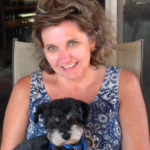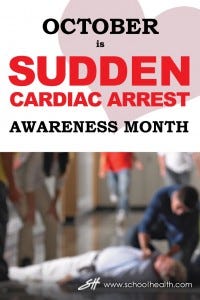October is Sudden Cardiac Arrest Awareness Month
- Oct 7, 2015
- 0 Comments
Saving a Life at Windsor Union Junior/Senior High School
 Karen Townsend, RN
Karen Townsend, RNOn a September day in 2015, Karen Townsend was working in her office when she received a call that would set any school nurse on edge: A teacher had collapsed in a classroom, while teaching. As a Registered Nurse, Karen has spent time working both in the classroom and operating room settings; she’s pretty much seen it all. But dealing with medical trauma that happens in front of students can add additional layers of complexity to any situation.
The call Karen received didn’t give her a lot of medical information about the incident. The teacher, we’ll call him John, had fallen backward from a standing position and was lying on the floor struggling to breathe. He was not responsive. Growing up in a small town in Vermont has its advantages. On one hand, you know everybody. On the other hand – you know everybody… Karen knew John and had worked with him for years. In fact, he was her math teacher when she was in high school.
Karen hurried out of her office as the students were being cleared from the room. On arriving, she visually assessed the situation. John’s color was terrible, she recalls, and his breathing was agonal (he was gasping for air). This was indeed a critical situation.
As luck goes, this was a very lucky day for John – even though it may not have seemed like it at the time. John is a retired teacher who works on a limited schedule. He wasn’t scheduled to work that day but had been called in to cover for another teacher. His doctors said that if he had been home, alone, without the immediate response of Karen and the other staff (some of whom were EMT’s) he wouldn’t have survived.
John had suffered a massive heart attack, also known as Sudden Cardiac Arrest. Every hour in the United States, approximately 38 people will have a cardiac arrest event outside of the hospital. Sudden Cardiac Arrest (SCA) is the number one killer of people today. During 2014 roughly 326,000 people suffered SCA. 3,000 of them were 21 years of age or younger. Of the 326,000 people who suffered SCA, roughly 90% of the victims died.
But with CPR and early defibrillation by an AED a victim’s chances of survival double, and in some cases triple. The only way to resuscitate an SCA victim is with early defibrillation (within 3 to 5 minutes). But by administering proper CPR during a cardiac emergency, the heart keeps pumping blood to the brain and vital organs – buying precious time while you wait for defibrillation. Luckily for John, Windsor Union Junior/Senior High School had an AED onsite and though it was 3 floors away, it was still close enough to save a life. Since this incident, the school has purchased 3 more AED’s – one for each floor.
Karen and the other staff continued with CPR while they attached the leads from the AED. At this time there was no discernable pulse and the AED delivered the first shock. CPR continued while the AED device analyzed John. His color began to improve but with a still-weak pulse the AED identified that a second shock was appropriate. After the second shock, John’s condition improved again and as the paramedics arrived with the ambulance John had begun to respond. Though he was not fully coherent before he left for the hospital, he was able to respond to the paramedics – a great improvement over his initial condition.
Assess Your Plan to Respond to SCA
[caption id="attachment_2060" align="alignleft" width="200"]
 October is Sudden Cardiac Arrest Awareness Month[/caption]
October is Sudden Cardiac Arrest Awareness Month[/caption]October is a time to focus on stories like this because it brings awareness to how to save even more lives. The only way to reduce the number of SCA deaths is by increasing the number of people trained in CPR and increasing the number of publicly accessible Automated External Defibrillators (AEDs). In fact, schools and communities that have comprehensive CPR and AED programs that include CPR/AED training achieve survival rates around 40% - over four times the national average.
And the benefits of CPR and AED programs extend beyond the victims of SCA themselves to the community around them. A great impact is felt by the friends and loved ones of an SCA victim. In Karen's case, the students in the classroom witnessed a horrible trauma. However, the situation was made somewhat better because Karen could tell the students that though his condition was serious, John was going to be Ok. A life was saved because Windsor had an AED onsite their staff had both CPR and AED training.
Studies have shown that people who feel comfortable performing CPR are significantly more likely to attempt life-saving resuscitation. Routine practice is needed to achieve the proper rhythm, depth, and rate of CPR. Karen recalls that administering CPR and the AED on this day was much different than during practice. Without the training and practice she'd received, she wouldn’t have felt as confidant beginning resuscitation. She may have hesitated or waited for someone else, resulting in delays that could have had grave consequences.
On this day, the school was prepared – and so were the staff and, as a result, a happy ending. Because of their preparation, John made it to the hospital in time. Once there, he received a stent and spent about 5 days recovering before being released to fully recover at home.
School Health has the products and resources you need to ensure that your staff has both the right equipment and the right training to respond during an emergency situation.
For more incredible save stories and insightful SCA information please visit the Sudden Cardiac Arrest Foundation.
Together we can work to be prepared for sudden cardiac arrest.
Thank you to Karen Townsend, RN and Windsor Union Junior/Senior High School for sharing their story.
